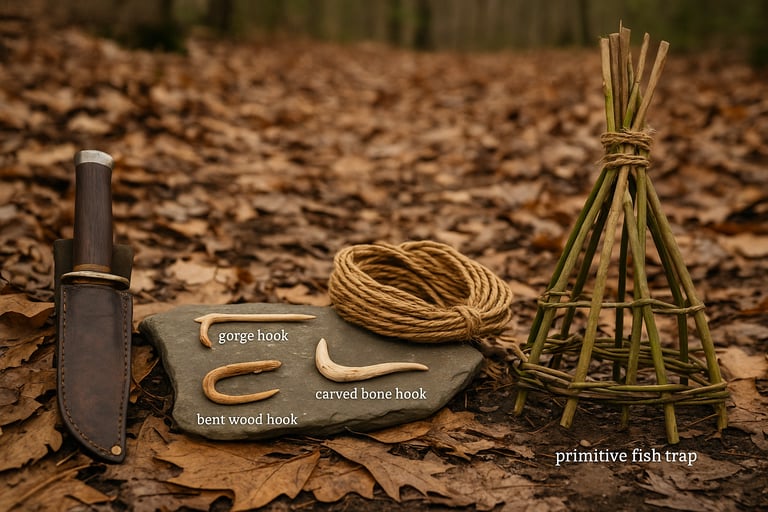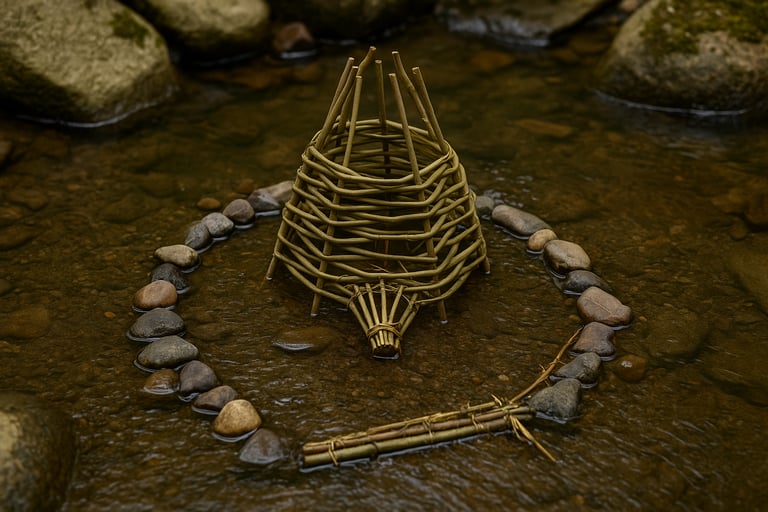Primitive Fishing Gear: How to Make Survival Hooks, Lines, and Fish Traps
Learn how to make primitive fishing gear in the wild — including gorge hooks, survival fishing lines, and DIY fish traps — using natural materials like bone, bark, and sticks. A practical wilderness survival guide for catching fish without modern tools.


Primitive Fishing Gear: How to Make Survival Hooks, Lines, and Fish Traps
When you’re out in the wild without modern tools, food security becomes a top priority. One of the oldest and most reliable ways to get protein is by fishing, and you don’t need a fancy rod and reel to do it. With a sharp knife, basic know-how, and some creativity, you can craft primitive fishing gear using natural materials.
In this guide, we’ll walk through how to make survival fishing hooks, lines, and traps from scratch, no store-bought supplies required.
Why Primitive Fishing Skills Matter in Wilderness Survival
Fishing in a survival setting isn’t about sport, it’s about efficiency and calories. Knowing how to construct simple, functional fishing gear gives you access to a renewable food source from lakes, rivers, and streams.
Even if you’ve never fished before, learning how to make a basic gorge hook, simple handline, or passive trap system can mean the difference between an empty stomach and a steady food supply. These methods are low-effort, high-reward and they keep working while you focus on shelter, fire, or other tasks.
How to Make Survival Fishing Hooks in the Wild
Primitive hooks don’t look like modern ones, but they work on the same principle: catch and hold the fish when it bites. The most basic version is the gorge hook — a small, sharpened stick or bone sliver carved to a narrow point on both ends.
To make one, start by cutting a thin piece of hardwood or bone to about 1.5–2 inches long. Sharpen both ends into angled points, then carve a shallow notch in the center to secure your fishing line. When baited and swallowed by a fish, the gorge turns sideways and lodges in the fish’s throat.
You can also carve curved hooks from animal bone or hardwood, mimicking the shape of a modern fishhook. Heat can be used to bend thin pieces of wood, and barbs can be notched in with a sharp stone or knife for better grip. If you're new to working with wood, learning how to safely carve bushcraft tools can make all the difference in crafting durable hooks or trap components.
Making Primitive Fishing Line from Natural Fibers
A hook is only as good as the line it’s tied to. In the wilderness, you can make cordage from natural plant fibers to create surprisingly strong fishing line.
Start with tough inner bark from trees like basswood, cedar, or juniper. These same natural fibers are excellent for crafting strong wilderness cordage for all types of survival uses. Strip it into thin strands, soak it in water, then twist it tightly using the reverse-wrap method to make a 2-ply line. For smaller fish, you can use thinner fibers like dogbane, nettle, or milkweed, twisted into finer cordage.
Your line should be long enough to reach the water with extra length for tying, baiting, and tension control. Always test its strength before using it, you don’t want a big catch to snap your line.
How to Make a Simple Wilderness Fish Trap
Passive fishing is the most efficient method in a survival scenario because it works while you rest, build shelter, or do other tasks. One of the best methods is a funnel fish trap made from sticks or woven reeds.
Find a shallow stream or narrow channel and build a V-shaped wall using rocks or sticks that funnel fish into a smaller gap. In the middle, place a basket-style trap with an inward-facing funnel made of sticks or woven vines. Fish swim in but can’t easily escape. Learning the basics of primitive basket weaving will help you build better, more durable traps from natural materials.
You can also dig a small pit or dammed pool along the bank and build a narrow entrance to guide fish in. Bait the inside of the trap with insects, crushed berries, or fish guts to increase your chances of a catch.
Tips for Using Primitive Fishing Gear Successfully
Fishing with handmade tools takes patience. Check your lines or traps regularly to ensure they're still intact. Secure your hooks well, and keep your bait as fresh and natural as possible — worms, bugs, grubs, or small fish pieces work well.
Place traps or lines in areas with visible fish activity — near rocks, under overhangs, or where the current slows. The more you observe the water, the better your chances.
Don’t be afraid to experiment. The best fishing setups often come from adapting to the specific environment you’re in.
Turn the Land Into a Food Source with Primitive Fishing Skills
Once you know how to make survival fishing hooks, natural line, and passive traps, you’ll never look at a stream or lake the same way again. With practice, these simple tools can feed you in nearly any environment, and unlike store-bought gear, they don’t break or run out.
Learning these primitive fishing methods not only boosts your self-reliance but deepens your connection to the natural world, a skillset that will serve you well in both survival scenarios and off-grid living.




© 2025. All rights reserved About | Privacy Policy | Terms and Conditions | Affiliate Disclosure | Disclaimer


